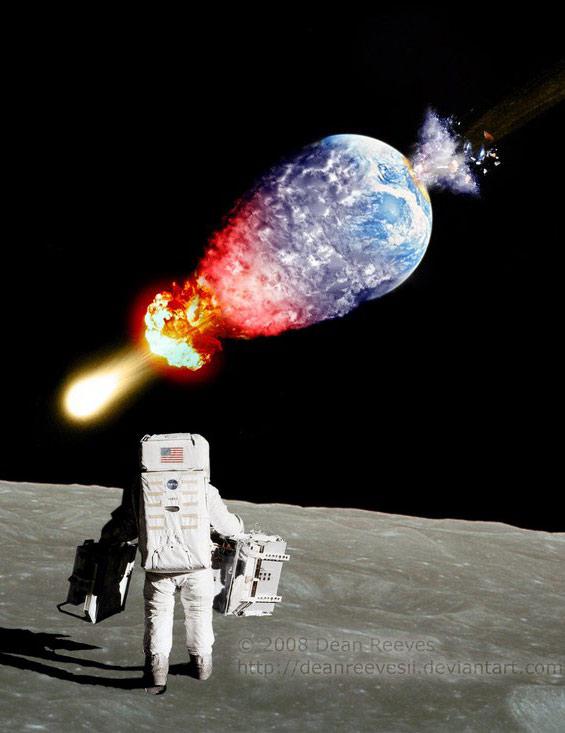Unless you’ve buried your head in the sand—which, to be honest, would be a better use of your time—you’ve heard the world is coming to an end today, Friday, Dec. 21, 2012.
OK, for those of you who are impatient and want to cut to the chase, here’s the scoop: No, it isn’t.
If you frequent online bulletin boards, fear-mongering websites, or the History Channel, you might think otherwise: It’s hard to avoid people screaming about the prophetic Maya calendar predicting global catastrophe.
And if you haven’t heard of it, then I wish I were you. Because I get email, tweets, Facebook messages, and probably smoke signals about it all the time, and have been for years. It turns out that a lot of people are concerned about these claims, despite zero evidence for them. Still, it’s worth taking a look at them, if only to assuage some fears.
Here’s the deal: According to the doomsday prophecy, the ancient Maya predicted the end of the world would occur on Dec. 21, 2012. We know this because that’s the date their calendar ends. While they weren’t specific about how Armageddon was to come about, there are a host of astronomical events that can and/or will occur that can reduce the Earth to a burned-out cinder.
Except not so much. Not a single thing I wrote in that previous paragraph basks in the warm glow of reality, despite being repeated ad nauseum by doomsday promulgators. It’s all nonsense, garbage, taurine feces, flim flam, and pifflery.
How so? Well, it just so happens I know a bit about this, and will happily (though grumpily) be your tour guide through this latest in a long (and, ironically, unending) series of dead-wrong end-of-the-world claims.
Welcome to the Maya Notpocalypse™.
Date With Destiny
The Maya were a clever bunch of folks. Their civilization got started several thousand years ago and reached its height by 900 A.D., spread over the Yucatan Peninsula in present-day Mexico. They had a sophisticated culture and were adept in agriculture and architecture. They had a complex written language and a keen system of mathematics. They were excellent astronomers, understanding the patterns of the stars and planets in the sky. And, of course, they had an advanced calendar. Several, in fact.
Keeping time is of paramount importance to any civilization. The Maya used different calendars for different purposes (we do too; there are fiscal calendars and monthly calendars and others that are arbitrary and headache-inducing, so don’t be too hard on the Maya). The calendar we’re interested in here is called the Long Count.
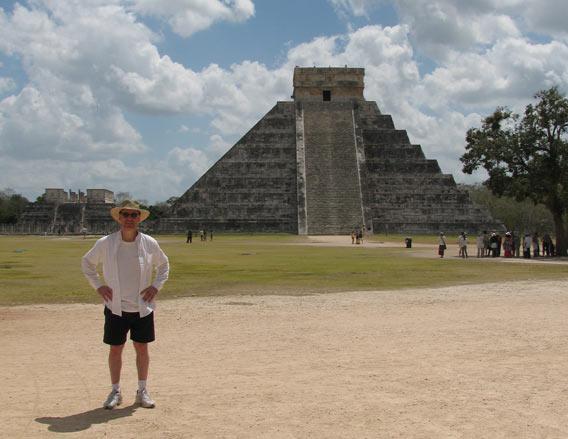
Image credit: Your snarky host.
It had as its basic units a day (called a k’in) and a 360-day period called a tun. The Maya understood that a physical year was five days longer than a tun, and had other calendars to deal with that. They had longer units, too, like the ka’tun—just shy of 20 years—and most importantly for apocalypse aficionados, the b’ak’tun—roughly 394 of our years. The starting point for their calendar (Year Zero, if you like) is 3114 B.C., the date they figured the Earth was created.
Knowing all this, we can match their calendar to ours and convert any date they used to our more familiar system. If you do the math, you’ll find that we are nearing the end of the 13th b’ak’tun. In fact, it ends on Dec. 21, 2012.
That’s today. Friday. Cue the spooky music.
The thing is, there is no suggestion, not even a hint, in Maya writing that they thought the end of this current b’ak’tun had any connection to doomsday. It’s entirely possible it may have even been thought of as a time of celebration (just like we celebrate New Year’s Eve).
The Maya also had bigger units of time, including the piktun (which was either 13 or 20 b’ak’tun), and the alautun, which was—get this—63 million years! So it doesn’t sound like they were predicting the end of the world ever, let alone by this weekend.
Anyway, it hardly matters. Just like our calendar, theirs was based on cycles. At the end of a cycle, you reset all the current units and move the biggest one up a notch. It’s what we do on December 31: Reset to the first day of the first month, and increment the year by one. Happy New Year! Same thing with the Long Count. After the last day of the 13th b’ak’tun, they’d start over at the next one.
So even the very basis of all this fear-mongering is wrong. But why let facts get in the way of a good doomsday?
The Fault Lies in the Stars

Image credit: Phil Plait
There’s a modern day land-grab in the field of doomsday prediction based on the Maya calendar. Books, videos, magazine racks, web sites, TV shows, Hollywood movies—doomsday is big money. You can find any information you want about the end of the world this week, as long as reality is something you’re willing to sacrifice.
So what are these prophets claiming? What could possibly destroy the Earth? After all, our planet is pretty big, so Earth-shattering kabooms are hard to come by (Illudium Q-36 Explosive Space Modulators notwithstanding).
Predictably—at least by me, but I’m biased—they turned mostly to astronomy. Space is filled with scary stuff, a lot of which seems bent on our destruction. Rogue planets, killer solar flares, and monstrous black holes are the Mayan apocalyptanators I see the most.
So, could these spindle, fold, or mutilate our world?
Exing out Planet X
Back in 2003, there was a big doomsday rumor flying around the web about a giant planet named Nibiru (or, more ominously, Planet X) that orbits the Sun every 3600 years. On May 15 of that year, so it was said, the planet would sweep past the Earth and cause all sorts of disasters. A lot of people really believed it, too.
You may remember that date as being one when the Earth wasn’t destroyed.
When the date came and went without Nibiru coming and going, I made a prediction: We hadn’t seen the last of it. Year 2012 nonsense is growing, I said, and I just bet Planet X will have its day in the spotlight again.
I hate being right all the time.
Nibiru is back, and as popular as ever. You can easily find a ton of web sites practically drooling over the idea. They claim that Nibiru is a giant planet (or possibly a brown dwarf, an object more massive than a planet but not quite a star) that will swing by the Earth, and its gravity will do us grave harm. Earthquakes, floods, bad weather, cats and dogs living together: You know the drill.
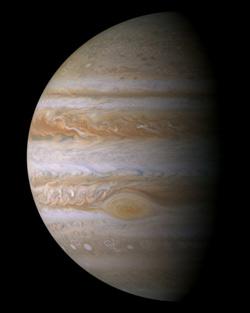
Image credit: NASA/JPL/Space Science Institute
But a planet massive enough to have that effect on us would have to be big. Like, Jupiter big, and Jupiter’s big. It would also have to be close by now, since we’re down to the wire on the doomsday thing: It would have to be no more than a few million kilometers away at most. That’s really close. Close enough to be fairly obvious in the sky, literally as big and bright as the full Moon! I’m thinking someone would’ve noticed by now.
So where is it?
Nowhere, is where it is. It doesn’t exist.
By the way, the Maya didn’t have telescopes, and while their math was good, advanced orbital calculations would’ve been beyond them. I suspect they wouldn’t have known about Nibiru even if it did exist. And of course, they never mentioned it. Because it didn’t. Exist, I mean.
So if doomsday is to come, it ain’t coming from a planet that wasn’t there. But what about a star? The nearest star, in fact?
A Flare for the Obvious
The Sun seems so friendly and helpful, lighting our sky and warming our planet. But it’s a feisty beast.
Every 11 years, the Sun’s magnetic field goes crazy. It gets amped way up and pops through the solar surface in dozens of places. We see these regions as sunspots, which are slightly cooler and darker than the rest of the Sun, but don’t be fooled: There is crazy violence in store there.
The tangled solar magnetic field lines contain ridiculous amounts of energy, and they can short out like crossed wires. When they do, they release all that stored energy in a single catastrophic blast called a solar flare. A big flare can explode with energy that can be a million times the combined nuclear arsenal of our entire world!
And, it so happens, we’re approaching the peak of the Sun’s cycle. Oh my god! The Maya were right!
Well, if you believe what the doomsdayers are saying, at least. They’ve been making this claim for five years or more, saying the Sun’s magnetic cycle will peak right around December 2012. That is, now.
But there’s just one problem: The Sun’s cycle won’t peak for another year. Oops.
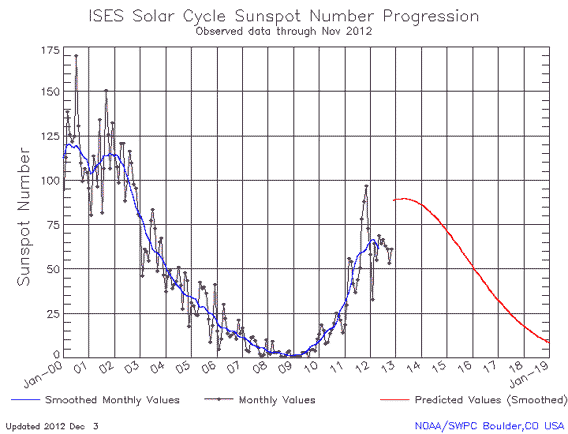
Image credit: NOAA/SWPC
We’re getting moderate activity on the Sun right now and have been for some time. And a few years back it did look like the peak would be right around now, but the Sun zagged when people thought it would zig: The quiet time between magnetic peaks lasted a lot longer than expected. That delayed the next peak, and it’s possible it won’t even happen until 2014. Not only that, but the really big flares tend to occur well after the peak by a few months.
Don’t get me wrong: Solar flares (and other storms from the Sun) are a cause for concern. They can damage satellites and cause power outages on Earth. But they can’t directly kill us here on the ground. They’re powerful, but they’re far away. The Sun is 150 million kilometers (90 million miles) from the Earth, which dilutes solar flares’ oomph by a lot. A widespread blackout would surely suck (especially if it lasted for weeks or months) and could cripple our civilization in many ways, but even a monster flare won’t cook us or irradiate us or anything like that.
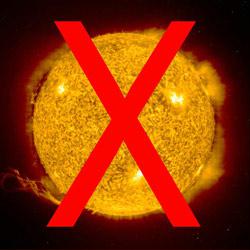
Image credit: NASA/ESA/SOHO
Mind you, 2003 was a period of very intense flare activity on the Sun, and we made it through that. I would like for power companies to take this threat more seriously, but the odds of a global catastrophe occurring this Friday aren’t terribly high.
And need I mention it again? The Maya didn’t know anything about sunspots, flares, or the Sun’s solar cycle.
Science: 2. Doomsday: 0.
But there’s another endtimer’s claim predicting dark days ahead. And not just dark, but black. Like a hole of some sort. Say.
Galactic Battlestar
At the heart of our galaxy lies a monster.
OK, mixed metaphors aside, there is something scary there: a black hole. And not just any black hole, but a supermassive one, as astronomers call it. Sitting smack dab in the center of our galaxy, it tips the cosmic scale at four million times the Sun’s mass.
Black holes, of course, are well-known for being the Universe’s ultimate vacuum cleaners, with gravity so strong nothing, not even light, can escape.
So of course it’s being (ab)used by doomsday purveyors. On Dec. 21, so they say, the Sun will align with this black hole, which will wreak havoc on our tiny world.
This one’s funny. Some of this is true: The black hole exists, for one, and the Sun does kinda sorta align with it. But that’s about it.

Image credit: NASA/JPL-Caltech
As the Earth makes its annual orbit around the Sun, we see the Sun make a circle against the starry background of the sky. Every year, the Sun passes through the constellation of Sagittarius, coincidentally the direction toward the center of the Milky Way, where that black hole lies. And it does do this in December!
But alas for the catastrophists, on its circuit of the sky the Sun never gets any closer to the black hole than five degrees away, a distance 10 times the size of the full Moon on the sky. That’s a pretty crummy alignment.
And even if it did perfectly align, it wouldn’t matter. Why not? That black hole is huge and massive and scary … but it’s really really far away. Its distance is about 26,000 light years from the Sun, or 260 quadrillion kilometers (150 quadrillion miles) from Earth! That’s 260,000,000,000,000,000 kilometers. A bit of a walk. Better pack a lunch.
If you do the math, you find that the force of gravity from the black hole on the Earth is a measly one-trillionth that of the Sun. You feel more gravity from your car when you’re standing next to it than from that black hole. When it comes to gravity, distance wins every time.
Oh, by the way: Guess what day the Sun actually passes the black hole in the sky. Go ahead, guess.
It’s December 19th, not the 21st. The doomsdayers didn’t even get the date right!
In the End
I could go on. And on and on and on until the Earth really does come to an end. I’ve seen claims of asteroid impacts (no asteroid we know of is on an impending collision course with our Pale Blue Dot), superstorms that will make Sandy look like an afternoon breeze (we can’t predict if it’ll rain next week, but the Maya could predict a huge storm centuries in advance?), the Earth flipping over (that turns out to be, ah, pretty hard to do), and even nebulous claims of some sort of cosmic vibrational uplifting (um, what?).
But there’s no real need to get into every single claim. The very calendrical basis of the doomsday idea is wrong, the claims themselves make no physical sense and are generally just wrong, and the Maya themselves make no mention of this date being doomsday in the first place.
If you’re still worried, ask yourself this: if the Maya could predict the end of the world 1,000 years in advance, why couldn’t they see the pending collapse of their own civilization?
When Saturday comes, and I can finally put a big X through Dec. 21 on my calendar, I will breathe a hearty sigh of relief. But my next breath will be a deep one, to prepare for the next bit of apocalyptic nonsense to come down the road. Because just as surely as this doomsday is nonsense, another will be along to replace it soon enough. I don’t know what it’ll be exactly, but I can be pretty sure it will be just as wrong as this one.
And I’ll have to write about it. The funny thing about the end of world: For skeptics, it’s actually job security.
